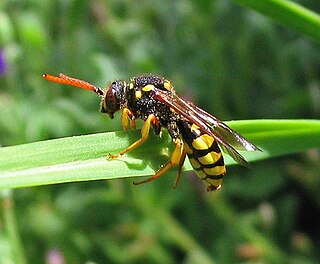
With over 850 species, the genus Nomada is one of the largest genera in the family Apidae, and the largest genus of kleptoparasitic "cuckoo bees." Kleptoparasitic bees are so named because they enter the nests of a host and lay eggs there, stealing resources that the host has already collected. The name "Nomada" is derived from the Greek word nomas, meaning "roaming" or "wandering."

The Andrenidae are a large, nearly cosmopolitan family of solitary, ground-nesting bees. Most of the family's diversity is located in temperate or arid areas. It includes some enormous genera. One of the subfamilies, Oxaeinae, is so different in appearance that they were typically accorded family status, but careful phylogenetic analysis reveals them to be an offshoot within the Andrenidae, very close to the Andreninae.

Andrena is a genus of bees in the family Andrenidae. With over 1,500 species, it is one of the largest genera of animals. It is a strongly monophyletic group that is difficult to split into more manageable divisions, currently, Andrena is organized into 104 subgenera. It is nearly worldwide in distribution, with the notable exceptions of Oceania and South America. Bees in this genus are commonly known as mining bees due to their ground-nesting lifestyle.

The tawny mining bee, Andrena fulva, is a European species of the sand bee (Andrena) genus. The males are 10–12 mm (0.4–0.5 in) and the females 8–10 mm (0.3–0.4 in) long. The female is covered with fox-red hair on the dorsal surface of its thorax and abdomen and black hair on its head and ventral surface. The male is less distinctive, being clad in golden-brown or reddish-brown hairs, with some long white hairs on the face, and a tooth on each of the mandibles.
Andrena salicifloris, or the willow flower miner bee, is a miner bee in the genus Andrena. Another common name for this species is the willow mining bee. The bee ranges from Colorado to California and north to British Columbia, and often inhabits arid and alpine lands. The bee is often black or dark brown, and is sparsely coated with grayish hair on the thorax, legs and on the abdomen. The pollen basket is on most of the hind leg. The wings of the willow flower miner bee are smokey, and their veins are black.

Andrena agilissima is a species of mining bee. They are present in most of Europe, the Near East and North Africa and can be found from April through July. Andrena agilissima is an oligolectic species, feeding only on the pollen of a few genera of Cruciferous vegetables.

Andrena hattorfiana is a species of mining bees belonging to the family Andrenidae subfamily Andreninae.
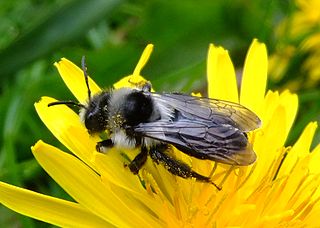
The ashy mining bee, also known as the Danubian miner or grey mining bee, is a species of sand bee found in Europe. Its distinctive colouring makes it one of the most easily recognised of the genus. The females are black, with two broad grey hair bands across the thorax. The male is also black although the thorax is entirely covered with grey hairs. The male has a tuft of white hairs on the lower face and white hairs on all femora while the female has white hairs only on the front femora. The female has twelve segments to their antennae and the male has thirteen.

Macropis nuda is a ground nesting, univoltine bee native to northern parts of North America. Thus, this species cocoons as pupae and hibernates over the winter. The species is unique as it is an oligolectic bee, foraging mainly for floral oils from Primulaceae of the genus Lysimachia.

Andrena scotica, the chocolate mining bee or hawthorn bee, is a species of mining bee from the family Andrenidae. It occurs in western Europe and is one of the most frequently encountered mining bees found in Great Britain, where it had been previously misidentified as Andrena carantonica.

Andrena trimmerana, Trimmer's mining bee, is a species of mining bee from the family Andrenidae. It occurs in the western Palearctic but its true status in some areas is muddled due to issues of taxonomy and misidentification.
Sphecodes schenckii is a solitary cleptoparasitic bee which is found in southern and eastern Europe and the Middle East. Its host is Lasioglossum discum and possibly Halictus simplex where L. discum does not occur such as in southern Germany and Switzerland. It is rare and there are only a few records from each country from which it has been recorded. It prefers warm open areas, such as grasslands and Mediterranean scrub, and may be threatened by reafforestation and vegetation succession. The specific name schenckii is in honour of the German Hymenopterist Adolph Schenck.

Sphecodes gibbus, the dark-winged blood bee, is a species of cleptoparasitic blood bee from the Palearctic. It is the type species of the genus Sphecodes and was first described by Carl Linnaeus as Sphex gibba in 1758.
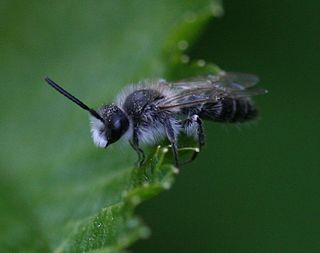
The bearded miner bee is a species of miner bee in the family Andrenidae. It is found in Europe and Northern Asia and North America. Other common names include the long-lipped andrena and the sandpit mining bee.
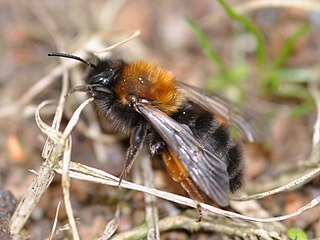
The Clark's miner bee is a species of miner bee in the family Andrenidae. Other common names include Clark's andrena and Clarke's mining bee. It is found in Europe and Northern Asia and North America.

Andrena bicolor, or Gwynne's mining bee, is a common and widespread Western Palearctic mining bee which is found over most of Europe as well as North Africa and the Middle East and which reaches eastwards into Siberia.
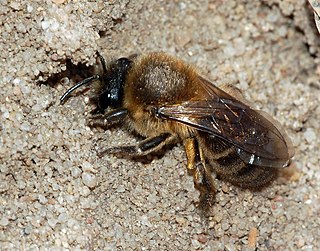
Colletes cunicularius, the vernal colletes or spring mining bee, is a species of solitary bee from the family Colletidae which is widespread in the Palearctic from Britain to the Pacific Ocean which nests in areas of open, sandy soil.

The tormentil mining bee is a species of mining bee from the family Andrenidae which has a Palearctic distribution.

Andrena helvola , the coppice mining bee, is a Palearctic species of mining bee from the genus Andrena.

















